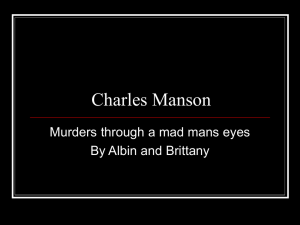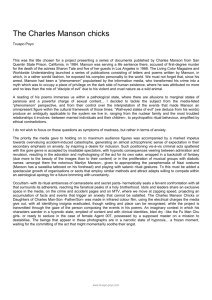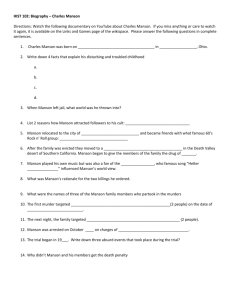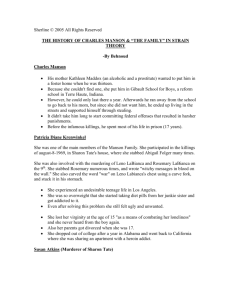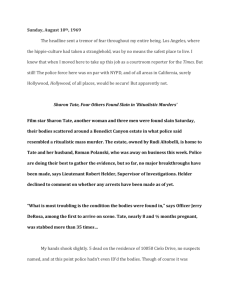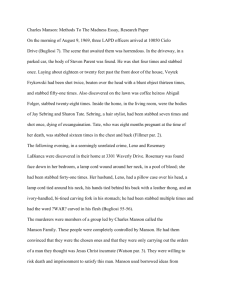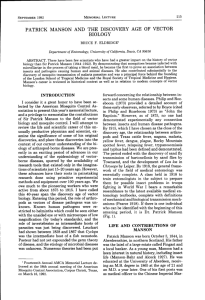Forensic Science and the Charles Manson Murders
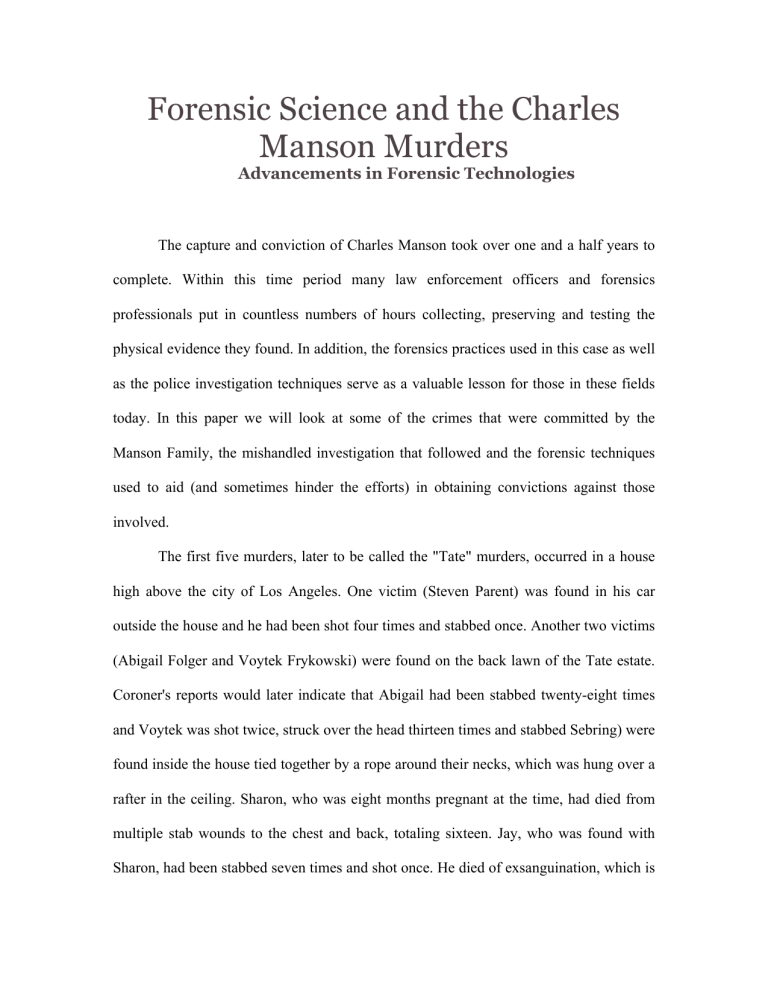
Forensic Science and the Charles
Manson Murders
Advancements in Forensic Technologies
The capture and conviction of Charles Manson took over one and a half years to complete. Within this time period many law enforcement officers and forensics professionals put in countless numbers of hours collecting, preserving and testing the physical evidence they found. In addition, the forensics practices used in this case as well as the police investigation techniques serve as a valuable lesson for those in these fields today. In this paper we will look at some of the crimes that were committed by the
Manson Family, the mishandled investigation that followed and the forensic techniques used to aid (and sometimes hinder the efforts) in obtaining convictions against those involved.
The first five murders, later to be called the "Tate" murders, occurred in a house high above the city of Los Angeles. One victim (Steven Parent) was found in his car outside the house and he had been shot four times and stabbed once. Another two victims
(Abigail Folger and Voytek Frykowski) were found on the back lawn of the Tate estate.
Coroner's reports would later indicate that Abigail had been stabbed twenty-eight times and Voytek was shot twice, struck over the head thirteen times and stabbed Sebring) were found inside the house tied together by a rope around their necks, which was hung over a rafter in the ceiling. Sharon, who was eight months pregnant at the time, had died from multiple stab wounds to the chest and back, totaling sixteen. Jay, who was found with
Sharon, had been stabbed seven times and shot once. He died of exsanguination, which is
bleeding to death and neither of the victims had actually died from hanging. The next two victims, in what would become known as the "LaBianca" murders, were found in a home in the Los Feliz section of Los Angeles. Leno and Rosemary LaBianca were found stabbed to death in their home. He had been stabbed multiple times and a knife and fork were found protruding from his body and she had been stabbed forty-one times. The departments working on the two investigations were the Los Angeles Sheriffs Office
(LASO) (LaBianca) and the Los Angeles Police Department ( LAPD ) (Tate). This would later play a very important role in the investigation in the year and a half due to mass miscommunication between the two departments concerning the two crime scenes.
Lack of communication between the two law enforcement entities put both cases in jeopardy several times during the investigations. For example, the word "PIG" was printed on the door at the Tate scene and the detectives from the LASO approached
LAPD detectives and told them of the writing of the words "Death to Pigs" in the victim's own blood at the LaBianca scene. When presented with possible evidence that the two crimes might be linked, Los Angles Police Department (LAPD) inspector K.J. McCauley told reporters "I don't see any connection between this murder (Tate) and the others.
They're too widely removed. I just don't see any connection" (Bugliosi 64). This was the official stance taken by the LAPD and the detectives proceeded to work solely on their own cases. In addition to the communication problems, the officers also encountered emotional, political, and mental stress from the shear senselessness of the crimes. One of
Manson's most faithful followers would later say "We wanted to do a crime that the world would have to stand up and take notice" (Bailey 1). As the first officers observed the horrific scene gradually unfold, they began to lose focus of their procedural duties
and there were also several mistakes made in the preservation and collection of evidence.
After arriving and securing the scenes officers, proceeded to assess the extent of the damage. What they found was shocking. A macabre scene of a massacre like no one had ever seen before. Upon making the grizzly discoveries the officers became less strict on their adherence to procedure and more intent on finding the killer or killers. The officers got sheets from the linen closet and covered the bodies. One week later the blue sheet that was used to cover Abigail Folger on the lawn would still be there. Although placing the sheets on the bodies was not a good idea, not transferring them to the lab with the bodies was worse. Police officers, being the first to arrive at the scene of a crime, must follow strict procedures in an effort to protect any shred of evidence that may be needed to obtain a conviction.
LAPD officers made several mistakes that could have potentially seriously damaged the prosecution's case. For example, Officer DeRosa, while he was escorting a possible suspect, down the driveway of the Tate estate noticed that there was blood on the button that opened the electric gate. According to Bugliosi in his book "Helter Skelter",
"Officer DeRosa, who was charged with securing and protecting the scene until investigating officers arrived, now pressed the button himself, successfully opening the gate but also creating a superimposure that obliterated any print that may have been there". (14)
Fingerprints would be a problem area for police throughout the investigations.
The gun used in the murders was discovered by a boy in Los Angles about two weeks after the murders. "The boy was careful not to touch the revolver to protect fingerprints.
The police smudged it up and filed it away, the chambers of the weapon containing seven
spent shells and two live bullets" (Sanders 355). Although the fingerprints on the gun were obliterated by police officials, forensics professionals were able to match a print from the front door of the Tate residence and one lifted from the frame on the inside door of Sharon Tate's bedroom to two of the suspects. These prints would become an important key to the prosecution's case.
In addition to eradicating fingerprints, officers made several other procedural mistakes. For example, pieces of a gun grip that were first seen near the entryway ended up under a chair in the living room. According to the official LAPD report: "They were apparently kicked under the chair by one of the original officers on the scene…."
(Bugliosi 16). On December 16 these pieces would be matched to the gun that had been in police custody since September 10, 1969 when the Los Angles boy had found it in his yard. Police probably would never have made the connection if the boy's father, having heard about the caliber of gun used in the murders, had not insisted that the police check it out. Since guns and other property are routinely disposed of after a period of time, prosecutors were rather lucky that the gun was still around.
Officers were also unable to locate any of the knives or bloody clothing from the murders. One of the Manson accomplices (Susan Atkins) divulged to a cell mate her involvement in the crimes, including a suggestion of the location where these items were thrown from the vehicle. A television news crew set out to find them. They used statements made by Atkins, such as "mountain on one side" and "ravine on the other" to guide their search. On December 15, much to the chagrin of the police, they found the clothing.
Forensic professionals were also lacking in the performance of their duties. One
in particular, Officer Joe Granado, a forensic chemist assigned to both cases, failed to note or sample blood spatters around the bushes where someone had apparently fallen at the Tate residence. He also did not take samples from the pools of blood around the two bodies in the living room, nor from the two bodies on the lawn. He later testified that he presumed that the blood surrounding the victims was their own and he would get those samples from the coroner later. Granado obtained forty-five blood samples from the Tate scene and he failed to run subtypes on twenty-one of those. Two days later at the
LaBianca scene he would take no subtypes which would cause major complications later in the trial. On the walkway leading to the Tate residence were several large pools of blood and Granado only took a sample from one of these pools, "presuming, he later said, all were the same" (Bugliosi 17). Unfortunately, officers at the scene tracked blood from inside the residence onto the front porch and walkway and back again, which compounded the problems. This made it necessary to interview all the individuals who had been at the scene about the shoes they had worn that day.
Although all these mistakes were made, officials were still able to put together enough evidence for trial. During the trial obvious signs of Manson's control over the family members was exhibited. At one point, Manson turned around and refused to face the judge. His followers, as well as his co-defendants did the same. When he shaved his head or carved an X in his forehead, they did too. He would also make periodic outbursts from time to time in the courtroom which his followers would repeat in a chant-like manner. All of these theatrics worked to the detriment of the defendants. Manson and four of his followers were subsequently convicted on all counts. This is somewhat extraordinary, because Manson never actually was present at the Tate murder scene.
"Prosecutor Vincent Bugliosi was faced with a difficult endeavor as it was. He proved that Manson, although not a direct participant, had ordered the Tate-LaBianca killings"
(Terry 606). He was present at the LaBianca scene, only long enough to tie up the victims. He then walked outside and told his followers to "kill them." All of the defendants were sentenced to death which was later commuted to life when California's laws were changed. Although he has come up for parole several times already there is little doubt as to whether he will remain in prison.
At various times Charles Manson's "family" numbered a hundred or more. Most of those have faded away. However, if you look around you can still find stragglers. The technological age has given birth to a new type of Manson follower, those with their own home pages on the internet. While researching this subject I came across at least 100 pages of information from the faithful. The consolation to this scary strategy is that forensics practices have advanced technologically, also. Errors committed by the officials in the Manson investigation are less often repeated in light of the advanced collection and procedural techniques of today. The murders committed at the command of this lone madman were astounding and senseless. Fortunately the investigation, although mishandled, produced convictions for all involved.
Works Cited
1.
Bailey, A. Charles Manson - Murder and 'Family' Man. World Wide Web ; 1995
2.
Bugliosi V, Gentry C. Helter Skelter. 16th ed. New York, NY: Bantam Books; 1974 :
3-664
3.
Sanders E. The Family. 1st ed. Toronto, Canada: Clarke, Irwin & Company; 1971: 21-
412
4.
Terry M. The Ultimate Evil. 2nd ed. New York, NY: Bantam Books; 1989: 497-640
This paper is edited by Scott Fillmer and a copyright of Deborah Fillmer All rights reserved, Copyright (c) 1997 by Deborah Fillmer, any comments or questions should be
sent to scott.fillmer@gmail.com
or deborahfillmer@gmail.com
Notation about this article:
This paper was originally written by Deborah Fillmer for a college course at UAB. It was originally published in 1997 from the original url of http://www.concentric.net/~dfillmer/Manson.htm or a shortened url of http://www.cris.com/~dfillmer/Manson.htm (other variations posted online are http://concentric.net/~dfillmer/Manson.htm and http://cris.com/~dfillmer/Manson.htm), which is no longer valid. This original location was canceled by accident by cris.com and we could not get it back.
You can look at the archive of this paper on the wayback machine , or click on this for the direct link to the originally published paper here and see that we did indeed publish this original paper at that time. This paper has been quoted and used with and without permission all over the internet so many times we felt like it needed to be put back up in its original form. There are many online sites that offer essays for a fee, and this is one of them. None of them received this paper by permission and if you use it, you are infringing on the copyright of Deborah Fillmer and as soon as you pass it on as a paper of your own you are plagiarizing this work.
Please do not do either.
What you see here is the original published copy from the original writer. For questions please contact us via email or the contact link above. This paper has not been changed from the original and although citations are needed, the paper appears as the original work was written in 1997. Any comments, questions, suggestions, or requests for use or quotes should be sent to the gmail address listed above.
